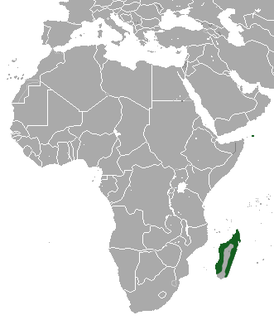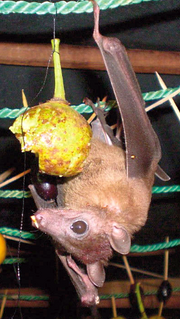
The aye-aye is a long-fingered lemur, a strepsirrhine primate native to Madagascar with rodent-like teeth that perpetually grow and a special thin middle finger.

Convolvulaceae, known commonly as the bindweed or morning glory family, is a family of about 60 genera and more than 1,650 species of mostly herbaceous vines, but also trees, shrubs and herbs, and also including the sweet potato and a few other food tubers.

The Pholcidae are a family of araneomorph spiders. The family contains over 1,800 pholcids, including those commonly known as the marbled cellar spider , daddy long-legs spider, granddaddy long-legs spider, carpenter spider, daddy long-legger, vibrating spider, gyrating spider, long daddy, and skull spider. The family, first described by Carl Ludwig Koch in 1850, is divided into 94 genera.

Heart of palm is a vegetable harvested from the inner core and growing bud of certain palm trees, most notably the coconut, juçara, açaí palm, palmetto, and peach palm. Harvesting of many uncultivated or wild single-stemmed palms results in palm tree death. However, other palm species are clonal or multi-stemmed plants and moderate harvesting will not kill the entire clonal palm. Heart of palm may be eaten on its own, and often it is eaten in a salad.

Ravenala is a genus of flowering plants with a single species, Ravenala madagascariensis, commonly known as the traveller's tree, traveller's palm or East-West palm, from Madagascar. It is not a true palm but a member of a monocotyledonous flowering plant family, Strelitziaceae. The genus is closely related to the southern African genus Strelitzia and the South American genus Phenakospermum. Some older classifications include these genera in the banana family (Musaceae). Although it is usually considered to be a single species, four different forms have been distinguished.

The Aponogetonaceae are a family of flowering plants in the order Alismatales. The Aponogetonaceae is considered to be allied to the Potamogetonaceae - Najadaceae complex of families.

Lapparentosaurus is a genus of sauropod dinosaur from the Middle Jurassic. Its fossils were found in Madagascar. The type species is L. madagascariensis.

The Madagascan big-headed turtle is a turtle native to the waters of permanent slow moving rivers and lakes in western Madagascar. These turtles are critically endangered and have been evaluated to be the most endangered turtle in the world by a 2018 review. Despite their vulnerability to extinction, they are commonly eaten for food and they are still commonly shipped from Madagascar to Asia to help meet the demand of Asia's traditional medicine market. A captive breeding program has also been started to prevent the species from becoming extinct. The Turtle Conservation Fund (TCF) intends to raise US$5.6 million to cover a five-year 'Global Action Plan' which includes captive breeding and reintroduction projects, trade monitoring, new rescue centers, local conservation plans, and educational programs.

The Far Eastern curlew is a large shorebird most similar in appearance to the long-billed curlew, but slightly larger. It is mostly brown in color, differentiated from other curlews by its plain, unpatterned brown underwing. It is not only the largest curlew but probably the world's largest sandpiper, at 60–66 cm (24–26 in) in length and 110 cm (43 in) across the wings. The body is reportedly 565–1,150 g (1.246–2.535 lb), which may be equaled by the Eurasian curlew. The extremely long bill, at 12.8–20.1 cm (5.0–7.9 in) in length, rivals the bill size of the closely related long-billed curlew as the longest bill for a sandpiper.

Ankarafantsika National Park is a national park in the Boeny Region of Madagascar. The closest city is Majunga 115 kilometres (71 mi) north of the park. Ankarafantsika is mostly tropical in climate type. The Sakalava people are the predominant ethnic group living and farming here. The greater big-footed mouse lives in the park and is not known anywhere else.

Several species of Malagasy hippopotamus lived on the island of Madagascar but are now believed to be extinct. The animals were very similar to the extant hippopotamus and pygmy hippopotamus. The fossil record suggests that at least one species of hippopotamus lived until about 1,000 years ago and other evidence suggests that the species may have survived until much more recently. A non-fossilized skull and tusk were found in Madagascar in 2019 by biologist Forrest Galante and Primatologist Cortni Borgerson, and were dated to less than 200 years old, possibly even surviving into the present day. The taxonomy of these animals is not resolved and not widely studied. The various species are believed to have survived into the Holocene epoch.

The Madagascar girdled lizard or Madagascar plated lizard is a species of lizard in the family Gerrhosauridae. It is found in Madagascar, some outlying islands and the Seychelles (Cosmoledo). This generally common lizard is found in a range of habitat types, including open and degraded humid forest at mid and low altitudes. It also occurs in plantations. On Cosmoledo, it occurs in open shrubland. This oviparous lizard grows to 30 cm (12 in) total length.

The Madagascan pygmy shrew is a species of mammal in the family Soricidae. It is the only known Malagasy shrew. Some taxonomists regard it as conspecific with the widely distributed Etruscan shrew, the smallest known mammal by mass, and likely to have been introduced to Madagascar from India or Southeast Asia by humans. It is found in Madagascar and the Comoros, at altitudes from sea level to 1500 m. It is thought to be more common in the less humid western and southern parts of Madagascar. This shrew may also be present on Socotra. The species is found primarily in forests, and is presumed to be solitary, nocturnal and insectivorous, like its relatives. The litter size is one or two. It is threatened by logging and other forms of deforestation.

The Madagascan rousette or Madagascar rousette, is a species of megabat in the family Pteropodidae endemic to Madagascar. Its natural habitat is subtropical or tropical dry forests. It is threatened by habitat loss.
The purple swamphen has been split into the following species:
Rhyopsocus is a genus of bird nest barklice in the family Psoquillidae. There are more than 20 described species in Rhyopsocus.
Echmepteryx intermedia is a species of scaly-winged barklouse in the family Lepidopsocidae. It is found in the Caribbean Sea, Central America, and North America.

Trogoderma variabile, the warehouse beetle, is a species of carpet beetle in the family Dermestidae. It is found in Europe, Asia, Central America, North America and Oceania.
Echmepteryx youngi is a species of scaly-winged barklouse in the family Lepidopsocidae. It is found in North America.
Thylacella is a genus of scaly-winged barklice in the family Lepidopsocidae. There are at least 20 described species in Thylacella.














